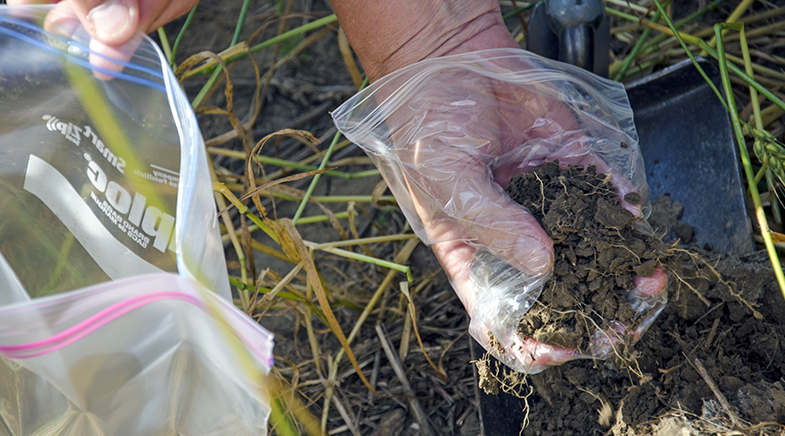A bowl of plastic, anyone?
-
- from Shaastra :: vol 04 issue 04 :: May 2025

Scientists worldwide are seeking robust tech solutions to the hazards of microplastics and nanoplastics.
The caddisfly is a small, moth-like insect that spends its larval life in water and adult life on land. It has an eye for the aesthetic and a taste for the exotic, which it expresses in constructing the portable casings where it spends its larval life. Binding with the silk it exudes are grains of sand and gravel, leaf litter and, often, a bright or shiny object such as glitter or gold flake. Tiny bits of plastic, sloughed off from what was once a bottle or a bucket, attract these tiny artists. Researchers have discovered these materials in casings found in nature; they have even induced the insects to pick these items for their construction, placing them strategically.
A recent study shows that the caddisflies' incorporation of synthetic polymers into their architecture is not a new trend. Researchers studied preserved specimens of caddisfly casings kept at the Naturalis Biodiversity Center, Leiden, Netherlands, and discovered a casing dating back to 1971, with three bright bits of yellow plastic pieces in it (bit.ly/larva-casing). The discovery proves that microplastics have impacted freshwater systems for at least 54 years. It also indicates that microplastics and nanoplastics (MNP) had, over five decades ago, even invaded pristine environments since the casing was picked up from a natural spring some distance away from urbanised areas.
THE CLEAN-UP CREW
While the caddisfly might have seen an attractive polymer as a decorative element, scientists worldwide are looking for solutions to end the MNP proliferation, as alarm bells sound at its potential to harm health and ecosystems. Researchers agree that multiple solutions grounded in robust technology are the way forward. These solutions range from physically removing MNPs from samples to harnessing microbial power to degrade them safely. Some initiatives include creating plastics that are biotransformed before they can end up as MNPs.
A reusable hydrogel can adsorb MNPs from water. In laboratory conditions, the low-cost hydrogel removed 93% of the MNP contamination.
At the Indian Institute of Science (IISc), Bengaluru, for instance, the Polymer Processing Group under Suryasarathi Bose, Professor, Department of Materials Engineering, has developed a reusable multi-layered hydrogel that can adsorb MNPs from a sample of contaminated water. In laboratory conditions, the low-cost hydrogel made with readily available ingredients — chitosan, polyvinyl alcohol, and polyaniline — removed 93% of the MNP contamination (bit.ly/hydrogel-MNP). Bose says the institute is in talks with a manufacturer to retrofit a filter of this hydrogel into its washing machines, with a collection mechanism for the spent gels.
Another such separator — developed by Kaustubha Mohanty and Senthilmurugan Subbiah of the Indian Institute of Technology (IIT) Guwahati — is a hollow fibre membrane filter that removes microplastics from seawater before extracting salt. However, the method does not account for MNPs that could get added to the salt during the processing cycle, as many machinery components also have plastic.

Such separation methods also leave behind a mound of MNPs, which need to be disposed of. Incineration is not a solution as it causes pollution. The IISc team demonstrated upcycling the adsorbate to form carbon dots, a nanomaterial, suggesting the possibility of a circular economy. "The MNPs can also be used as material in making upcycled products from plastic waste," Bose says.
The biotechnology approach looks at enzymatic and microbial remediation. Researchers bio-prospect for microbes, worms, and insects that show potential for degrading long-chain polymers to smaller molecules. In an ideal situation, such biota should reduce the polymer to water and carbon dioxide; in most cases, they aid the degradation of long chains to smaller ones, actually speeding up the production of MNPs.
So, research is now focused on degrading these polymers in controlled environments instead of in landfills, thereby retrieving the resultant monomers. A French team, for instance, reported in 2024 that it used enzymes isolated from the Ideonella sakaiensis bacteria to degrade Polyethylene Terephthalate (PET) into monomers and create "biologically recycled" PET, with the same properties as PET derived from petrochemicals (go.nature.com/4cNIVDq).
Bioremediation is the best way to tackle the MNP problem, reckons Sanjukta Patra, Professor of Biosciences and Bioengineering, IIT Guwahati. Her team engineered an enzyme, Mors1, from a bacterium called Moraxella TA144, that degrades PET into smaller compounds. Patra says these were not harmful when tested on "sensitive microbes". The bacteria, isolated from Antarctica, can degrade various synthetic polymers. European scientists had earlier demonstrated the polymer-degrading potential of another Moraxella-derived polyesterase (enzyme). Patra's lab is also working on the feasibility of marshalling an engineered version of the bacterium for the complete degradation of PET.
Most bio-based technologies, however, are yet to emerge from labs and pilots and get deployed on a mass scale. The French biotech firm CARBIOS, which has partnered with major consumer product manufacturers to popularise biorecycled plastic as product containers, claims to have the technology for the enzymatic degradation of PET and polylactic acid (PLA). It has yet to operate on an industrial scale; it began constructing its first commercial-scale PET depolymerisation plant in 2024.
TURNING OFF THE TAP
The scale of global MNP production — estimated at 10-40 million tonnes at present, which may double by 2040 — far overwhelms the scope of proposed solutions. Even if all new emissions are halted, MNP concentrations will continue to rise with the degradation of legacy plastics. "We do not have the luxury to focus just on clean-up; we need to stop the microplastics of tomorrow," says Richard Thompson, co-coordinator of the Scientists' Coalition for an Effective Plastics Treaty, an international body pressing for common legislation to curb plastic pollution. "First stop, then mop," says Thompson, who coined the term microplastic 20 years ago (see interview: Richard Thompson on ways to address the plastics pollution problem).

A recently published study led by IIT Bombay and Columbia University, U.S., explains how semi-crystalline polymers (comprising 70% of commercially used plastic) degrade. The researchers state that over time, the bonds between the crystalline and amorphous layers break down; the amorphous phase continues to degrade, but the crystalline fragments persist as nanoplastics (go.nature.com/3GrryfD). Engineering better connections between the layers could prevent nanoplastic formation, but the resultant material will be difficult to process into a desired product, notes Guruswamy Kumaraswamy, a corresponding author and Head of IIT Bombay's Chemical Engineering Department.
Yet, not all polymers are alike. The researchers note that non-crystalline analogues such as polystyrene break down into oily residues instead of nanoplastics, although the process takes several decades. In principle, such polymers can be bioremediated by nature. There is, however, a wide gap between the rate at which these plastics are produced and the time taken for natural degradation. "We are also looking at different (semi-crystalline) polymers to see if their chemistry influences how they break up," Kumaraswamy says. "It is not easy to find replacements for such a useful, versatile, and durable material."
Not all polymers are alike. Non-crystalline analogues break down into oily residues instead of nanoplastics, although the process takes several decades.
Bose holds that "aggressively recycling end-of-life plastic waste" prevents much of it from degrading into MNPs in the environment. Some polymers already have a good circular economy: PET bottles, for instance, are degraded to create fibre used in textiles. IISc has partnered with a Bengaluru-based deep-tech firm VOiLA3D to convert end-of-life, post-consumer plastic waste into products such as cafeteria furniture, trash bins, corridor seating, and road dividers. According to Bose, VOiLA3D uses a patented robotic 3D-printing system that can repurpose up to 73,000 kg of plastic waste annually.
Another company — U.K.-based Polymateria, which recently set up a unit in India — has a "biotransformation technology" aimed at polyethylene and polypropylene, the two plastics most likely to end up in the open environment as bags, straws, containers, face masks, and diapers. It has patented a 'master batch', which, when added at the plastic manufacturing stage, imbues the resultant material with the ability to "fully biodegrade and return to nature" in two years, says the organisation's Chief Corporate Affairs Officer Steven Altmann-Richer. While the formulation of the master batch is a trade secret, Altmann-Richer says it comprises 2% of the final product's weight and has cleared tests for toxicity and food safety. The ten-year-old outfit has partnered with organisations in Asia and the U.K. to create products such as cups, straws, and bags.
ALT PLASTIC
Alternatives to petroleum-based plastics are often promoted as bioplastics or biodegradable plastics. A renewable source of carbon — such as corn, cane, and cassava — doesn't make the plastic behave any differently but takes the dependence away from a non-renewable resource, Thompson points out.
Plastics were created as alternatives to natural materials. Now, researchers are looking for polymers that mimic some functions of plastics but have a different chemistry and degradation span. Seaweed-derived polysaccharides such as alginates and carrageenans show potential for creating single-use products such as food wraps and bags since they degrade completely, says Kumaraswamy. Materials such as chitosan are being explored, too. However, these ideas are yet to take off at scale to compete with the mass and cheap production of plastics. Further, quick biodegradation may be on the back burner when the focus is on durability, as in plastic mulching or making components for machinery.
Some of the answers will come from a future material revolution, Thompson believes. Today, materials are not designed with end-of-life considerations, he notes. Factoring such requisites into the design stage will reduce the amount of plastics left to degrade. "We do not have the science for it today, but science will offer solutions in the future. Science was critical in defining the problem and providing the evidence. It will bring about solutions, too," he says.
HERE, THERE, EVERYWHERE
The jury is still out on the health risks posed by MNPs.
From freshly fallen snow in Antarctica to the depths of the Mariana Trench in the Pacific Ocean, microplastics and nanoplastics (MNPs) are everywhere. Microplastics are fragments or shards of plastic less than 5mm in dimension, while nanoplastics are less than 1 micrometre in size. These are present in food chains and in human organs, especially the brain. Microplastics have also been detected in human placentas (bit.ly/Plastic-Placenta).
In ongoing research at the Indian Institute of Technology (IIT) Madras, investigators kept Petri dishes in different indoor environments. They discovered the filter papers on the dishes loaded up with strands of microplastic fibres within days.

MNPs have been seen in human placentas.
"The more domesticated a space — with curtains, carpets, towels, and upholstery — the more the microfibres," says IIT postdoc researcher Angel Jessieleena.
But while the pervasiveness of MNPs has been widely documented, their impact on human health is still being studied. Associative data indicate a potential adverse effect — likely toxicity, immunomodulation, respiratory and development issues, and cancer.
Recent research on preserved organs from cadavers in New Mexico, U.S., shows that microplastic concentrations are up to 30 times higher in the brain than in the liver, kidneys, and other organs. The levels are higher in people who have dementia. The researchers studied autopsy samples and found MNP concentrations in the brain had increased from 2016 to 2024 (go.nature.com/4jmzBca).
Have a
story idea?
Tell us.
Do you have a recent research paper or an idea for a science/technology-themed article that you'd like to tell us about?
GET IN TOUCH














